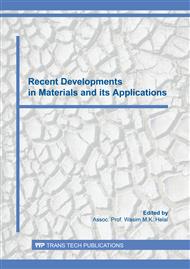[1]
Y. Guerin, G. S. Was, S. J. Zinkle, Materials Challenges for Advanced Nuclear Energy Systems. MRS Bulletin 34 (1), (2009) 10-14.
Google Scholar
[2]
Basic Research Needs for Advanced Nuclear Energy Systems: Report of the Basic Energy Sciences Workshop on Basic Research Needs for Advanced Nuclear Energy Systems; U.S. Department of Energy Office of Basic Energy Sciences: (2006).
DOI: 10.2172/899045
Google Scholar
[3]
Simulation Based Engineering Science - Revolutionizing Engineering Science through Simulation; National Science Foundation: (2006).
Google Scholar
[4]
G. S. Was, Fundamentals of Radiation Materials Science (Springer, Heidelberg, 2007).
Google Scholar
[5]
M. S. Veshchunov, R. Dubourg, V. D. Ozrin, V. E. Shestak, and V. I. Tarasov. 2007. Mechanistic Modelling of Urania Fuel Evolution and Fission Product Migration during 320 Irradiation and Heating., Journal of Nuclear Materials. 321 https://doi.org/10.1016/j.jnucmat.2007.01.081.
DOI: 10.1016/j.jnucmat.2007.01.081
Google Scholar
[6]
Lee, W. E., Gilbert, M., Murphy, S. T., & Grimes, R. W. (2013). Opportunities for Advanced Ceramics and Composites in the Nuclear Sector. Journal of the American Ceramic Society, 96(7), 2005–2030.
DOI: 10.1111/jace.12406
Google Scholar
[7]
Eriksen, Trygve E., David W. Shoesmith and Mats Jonsson. Radiation induced dissolution of UO2 based nuclear fuel - A critical review of predictive modelling approaches., 420(1-3) pp (409-423) (2012).
DOI: 10.1016/j.jnucmat.2011.10.027
Google Scholar
[8]
F. Thuemmler, R. Theisen, E. Patrussi, Technical Report KFK-543, Kernforschungszentrum, Karlsruhe, Germany, p.44, (1967).
Google Scholar
[9]
P. Tiwary, A. Van De Walle, and N. Grønbech-Jensen, Ab initio construction of interatomic potentials for uranium dioxide across all interatomic distances,, Phys. Rev. B - Condens. Matter Mater. Phys., vol. 80, no. 17, (2009).
DOI: 10.1103/physrevb.80.174302
Google Scholar
[10]
K. Yamada, K. Kurosaki, M. Uno, and S. Yamanaka. 2000. Evaluation of Thermal Properties of Uranium Dioxide by Molecular Dynamics., Journal of Alloys and Compounds. https://doi.org/10.1016/S0925-8388(00)00806-9.
DOI: 10.1016/s0925-8388(00)00806-9
Google Scholar
[11]
T. Arima, S. Yamasaki, Y. Inagaki, and K. Idemitsu. 2005. Evaluation of Thermal Properties of UO2 and PuO2 by Equilibrium Molecular Dynamics Simulations from 300 to 2000 K., Journal of Alloys and Compounds. https://doi.org/10.1016/j.jallcom.2005.04.003.
DOI: 10.1016/j.jallcom.2005.04.003
Google Scholar
[12]
T. Arima, S. Yamasaki, Y. Inagaki, and K. Idemitsu. 2006. Evaluation of Thermal Conductivity of Hypostoichiometric (U, Pu)O2-x Solid Solution by Molecular Dynamics Simulation at Temperatures up to 2000 K., Journal of Alloys and Compounds. https://doi.org/10.1016/j.jallcom.2005.08.003.
DOI: 10.1016/j.jallcom.2005.08.003
Google Scholar
[13]
S. Nichenko, and D. Staicu. 2014. Thermal Conductivity of Porous UO2: Molecular Dynamics Study., Journal of Nuclear Materials. 299 https://doi.org/10.1016/j.jnucmat.2014.08.009.
DOI: 10.1016/j.jnucmat.2014.08.009
Google Scholar
[14]
W. Mingjie, Z. Li, D. Jiguang, H. Duohui, W. Lili, and Jiang Gang. 2012. The MD Simulation of Thermal Properties of Plutonium Dioxide., Physica B: Condensed Matter. https://doi.org/10.1016/j.physb.2012.08.010.
DOI: 10.1016/j.physb.2012.08.010
Google Scholar
[15]
K. Govers, S. Lemehov, M. Hou, and M. Verwerft. 2009. Molecular Dynamics Simulation of Helium and Oxygen Diffusion in UO2±x., Journal of Nuclear Materials. https://doi.org/10.1016/j.jnucmat.2009.10.043.
DOI: 10.1016/j.jnucmat.2009.10.043
Google Scholar
[16]
Ma, Li, and Asok K. Ray. 2012. Formation Energies and Swelling of Uranium Dioxide by Point Defects., Physics Letters, Section A: General, Atomic and Solid State Physics. https://doi.org/10.1016/j.physleta.2012.03.017.
DOI: 10.1016/j.physleta.2012.03.017
Google Scholar
[17]
Plimpton, S. 1995. Fast Parallel Algorithms for Short – Range Molecular Dynamics., Journal of Computational Physics 117 (June 1994): 1–19. https://doi.org/10.1006/jcph.1995.1039.
DOI: 10.1006/jcph.1995.1039
Google Scholar
[18]
Biersack, J.P., and J.F. Ziegler. 1985. The Stopping and Range of Ions in Solids., Ion Implantation Techniques Springer Series in Electrophysics Volume 10, no. Volume 1: 122–56. https://doi.org/10.1007/978-3-642-68779-2-5.
DOI: 10.1007/978-3-642-68779-2_5
Google Scholar
[19]
M.S. Daw, M.I. Baskes, Embedded-atom method: Derivation and application to impurities, surfaces, and other defects in metals, Phys. Rev. B. 29 (1984) 6443–6453.
DOI: 10.1103/physrevb.29.6443
Google Scholar
[20]
Allen, M. P. 2004, Introduction to Molecular Dynamics Simulation", Computational Soft Matter: From Synthetic Polymers to Proteins, Lecture Notes,, Vol (23), pp.1-28.
Google Scholar
[21]
S. Vyas, R.W. GrIMES, V. Bulatov, and M. Abramowski. The surface structure of CaF2; a comparison of techniques. Molecular Simulation, 26:307-321, (2001).
DOI: 10.1080/08927020108023016
Google Scholar


